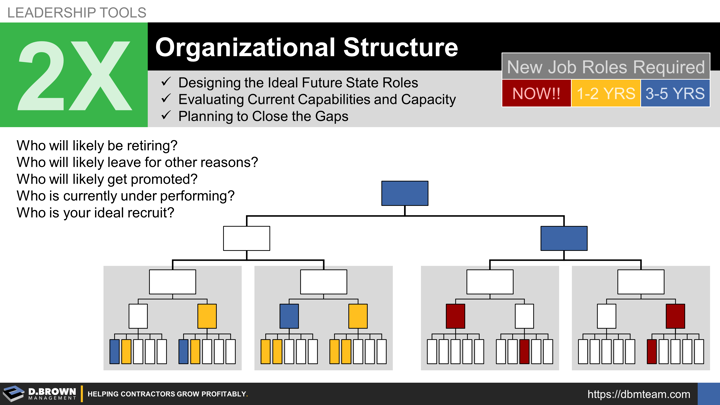Like a facility, you don't have to have every detail figured out before starting and there will be changes along the way. Also, like building a facility, if changes and information flow are not managed effectively then schedules, budgets, and quality will suffer.
PREREQUISITES
This is the third part of a continuous organizational evaluation and planning cycle that started with Current State, then a 50 Percent Scenario Planning which set us up for the 2X Scenario Planning below.
2X growth will occur in about 7 years at a 10% average annual growth rate, 5 years at 15% and 4 years at 20%. The rate of growth will dramatically change your planning.
About every tripling of headcount requires different strategies, systems, structure, and leadership focus. Planning for 2X is an interim step. If the team's readiness for growth is currently "Hollow," then the changes required may be significant.
If the management team is currently "Ready," then the changes may be mostly around additional quantities of existing roles, which will still be a challenge given the industry-wide shortage of talent that will only worsen through 2030 and the time it takes to develop capabilities.
Basic Resource Planning of Existing Roles (Step 1)
Start with basic resource planning. Look at your strategy and business model at 2X the current size. Look at your history and some basic metrics. Expand your business model out to basic quantities of front-line roles. How many estimators? How many craft? How many PMs? How many Supers? How many Payroll?
This step doesn't have to be perfect. It is just a rough estimate for planning. The equivalent of the Programming or Pre-Design phase of a project.
New Roles (Step 2)
Does your strategy necessitate adding a capability that will require new role(s)? For example, adding preconstruction as a shift into a more CM At Risk project delivery as part of your strategy?
With growth, will it make sense to split some roles apart by moving them from more generalized to more specialized? For example, breaking out the Business Developer role from the Executive role when it comes to winning projects.
With growth, will you require additional higher-level management roles to help integrate functions, ensuring smooth flow of work across a larger team? For example, make sure that all operations supporting the field - such as design, purchasing, fabrication, fleet, and logistics - are providing the project team with what they need, when they need it. These are job roles working at the Manager of Managers Leadership Pipeline Level and a comfortable Stratum IV in the Stratified Systems Theory (SST).
Layout the Draft Structure (Step 3)
Don't think about names at this point, just job roles. Remember that you are designing the outline for your business at this stage, just like the Schematic Design phase of a project.
The big things you are looking for is whether it makes sense after seeing it all in a diagram.
- Is there clarity on authority, accountabilities, and responsibilities?
- Is the number of direct reports reasonable for each supervisor and manager role?
- Do the job roles look reasonable or do they require unicorns?
Review Against Current Job Descriptions (Step 4)
Don't take a long time with this but look at each role as you see it on the future-state org structure and make notes about whether it:
- Remains the same
- Needs minor updates
- Needs major revisions
- Needs to be developed from scratch
Remember that even for the same job role, the President of a Stage 3 contractor (50ish people) will be very different than the job role requirements for the President of a Stage 4 contractor (150ish people). It is the same for all roles. A PM at Stage 3 is dramatically different than a PM at Stage 5 (500ish people).
Your objective at this point is to just identify the changes required, not to update everything.
Color Code Your Priorities (Step 5)
Start by bringing forward all your information from your Current State evaluation and laying it over your Future State plan.
- Who on your team do you think can comfortably take on these job roles? Look for individuals who are currently performing well in similar levels of roles or those who demonstrate both the desire and aptitude for promotion to other roles.
- Who will be retiring and what is the timeframe? That will leave open roles to fill.
- Who is a retention risk and may have left the company by the time you get to the future? That will leave open roles.
You should see quite a few open roles at this point. Start color coding those based on your timeframe to fill: NOW!! (Red), 1-2 Years (Orange), 3-5 Years (Blue).
This color-coded chart forms the foundation of your planning.
- Some of these discussions are great to have with a broader team to align them.
- Others require a much smaller group because you are objectively talking about capabilities.
- A few will be very individual decisions from the top, which is where a board of directors and experienced but unbiased 3rd parties can be invaluable.

